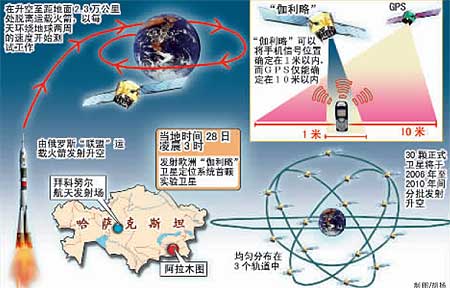The basic principle of satellite navigation system
The basic principle of the GPS navigation system is to measure the distance from a satellite of known position to the user's receiver, and then synthesize the data from multiple satellites to know the exact location of the receiver. To achieve this, the position of the satellite can be found in the satellite ephemeris according to the time recorded by the on-board clock. The distance from the user to the satellite is obtained by recording the time it takes for the satellite signal to propagate to the user and multiplying it by the speed of light (due to the interference of the ionosphere in the atmosphere, this distance is not the real distance between the user and the satellite, but is a pseudo distance (PR): when the GPS satellite is working properly, it will continuously transmit navigation messages with pseudo-random codes (pseudo-code for short) composed of binary code elements of 1 and 0. The pseudo-code used by the GPS system is a total of 1 and 0, respectively. There are two kinds of pseudo-random codes used in the GPS system, namely, civil C/A code and military P(Y) code. C/A code has a frequency of 1.023MHz, a repetition period of one millisecond, and a code spacing of 1 microsecond, which is equivalent to 300m; P code has a frequency of 10.23MHz, a repetition period of 266.4 days, and a code spacing of 0.1 microseconds, which is equivalent to 30m; while Y code is formed on the basis of P code, with better confidentiality performance. better. Navigation message includes satellite ephemeris, working condition, clock correction, ionospheric delay correction, atmospheric refraction correction and other information. It is demodulated from the satellite signal and transmitted on the carrier frequency with 50b/s modulation. Each main frame of the navigation message contains five subframes each of which is 6 s. The first three frames each have 10 character codes; they are repeated every thirty seconds and updated every hour. The last two frames have a total of 15,000 b. The contents of the NAV message are mainly telemetry code, conversion code, the 1st, 2nd, and 3rd data blocks, of which the most important is ephemeris data. When the user receives the navigation message, the satellite time is extracted and compared with their own clock to know the distance between the satellite and the user, and then use the satellite ephemeris data in the navigation message to deduce the location of the satellite transmitter message, the user in the WGS-84 geodetic coordinate system, such as the position of the user's speed and so on can be known.
It can be seen that the role of the satellite part of the GPS navigation system is to continuously transmit navigation messages. However, as the user receiver using the clock and satellite on-board clock can not always be synchronized, so in addition to the user's three-dimensional coordinates x, y, z, but also to introduce a Δt that is, the satellite and the receiver between the time difference as an unknown, and then use four equations will be solved out of these four unknowns. So if you want to know where the receiver is located, it must be able to receive signals from at least 4 satellites.
GPS receivers can receive time information accurate to nanoseconds that can be used for timing; forecast ephemeris used to predict the approximate position of satellites in the next few months; broadcast ephemeris used to calculate the coordinates of the satellites needed for positioning, with an accuracy of a few meters to a few tens of meters (varying from satellite to satellite and changing at any time); and GPS system information, such as the status of the satellites, and so on.

GPS receiver on the code measurement can be obtained from the satellite to the receiver distance, due to contain the receiver satellite clock error and atmospheric propagation error, it is called pseudo-distance. The pseudo-distance measured on the 0A code is called UA code pseudo-distance, the accuracy of about 20 meters, the pseudo-distance measured on the P code is called P code pseudo-distance, the accuracy of about 2 meters.
GPS receivers on the received satellite signals, decoding or other techniques, the modulation in the carrier information is removed, the carrier can be restored. Strictly speaking, the carrier phase should be referred to as the carrier beat frequency phase, which is received by the Doppler shift affected by the satellite signal carrier phase and the receiver's local oscillation generates the difference between the signal phase. Generally in the receiver clock to determine the calendar element moment measurement, to maintain tracking of satellite signals, you can record the value of the phase change, but the beginning of the observation of the initial value of the phase of the receiver and the satellite oscillator is not known, the beginning of the calendar element of the phase integer is not known, that is, the whole week of the fuzzy degree, can only be used as a parameter in the data processing solution. The accuracy of phase observation is as high as millimeter, but the premise is to solve the whole week ambiguity, so only in relative positioning, and have a period of continuous observation can use phase observation, and to achieve better than meter level positioning accuracy can only use phase observation.
According to the positioning method, GPS positioning is divided into single-point positioning and relative positioning (differential positioning). Single-point positioning is the way to determine the position of a receiver according to the observation data of a receiver, which can only use pseudo-distance observation, and can be used for approximate navigation and positioning of vehicles and ships, etc. Relative positioning (differential positioning) is the way to determine the position of a receiver according to the observation data of a receiver. Relative positioning (differential positioning) is based on the observation data of more than two receivers to determine the relative position between the observation points, it can use both pseudo-ranging observations and phase observations, geodetic or engineering measurements should be used to phase observations for relative positioning.
In the GPS observation volume contains the satellite and receiver clock difference, atmospheric propagation delay, multipath effect and other errors, in the positioning calculation is also subject to the satellite broadcast ephemeris error, in the relative positioning most of the public error is offset or weakened, so the positioning accuracy will be greatly improved, dual-frequency receiver can be based on the two frequencies of the observation volume to offset the main part of the ionospheric error in the atmosphere, in the precision In the case of high precision and long distance between receivers (with obvious difference in the atmosphere), dual-frequency receivers should be used.
Timing signals from GPS satellites provide information on latitude, longitude and altitude, and precise distance measurements require precise clocks. Therefore accurate GPS receivers use relativistic effects.
A GPS receiver that is accurate to within 30 meters means it has utilized relativistic effects. Clifford M. Will, a physicist at the University of Washington, explains in detail: “If relativistic effects were not taken into account, the clocks on the satellites would be out of sync with those of the Earth. ” Relativity theory holds that fast-moving objects pass more slowly with time than stationary ones.Will calculates that each GPS satellite spans a distance of about 14,000 kilometers per hour, which means that its on-board atomic clocks are seven microseconds slower per day than those on Earth.
And gravity exerts an even greater relativistic effect on time. At an altitude of about 20,000 kilometers, GPS satellites experience a gravitational pull equal to about a quarter of that on the ground. The result is that the on-board clock is 45 microseconds per day faster, and GPS has to account for a total of 38 microseconds of deviation. Ashby explains: & ldquo; If there is no frequency compensation on the satellite, the error will increase by 11 kilometers per day (this effect is factually more complicated because the satellite is along an eccentric orbit, sometimes closer to the Earth, sometimes farther away).
Due to the satellite orbit, satellite clock error, the atmospheric troposphere, the ionosphere on the signal, as well as man-made SA protection policy, so that the civil GPS positioning accuracy of only 100 meters. In order to improve the positioning accuracy, differential GPS (DGPS) technology is commonly used to establish a reference station (differential station) for GPS observation, and use the known precise coordinates of the reference station to compare with the observed value, so as to derive a correction number and release it to the public. After the receiver receives the correction number, it compares it with its own observation value, eliminates most of the errors, and obtains a more accurate position. Experiments have shown that using differential GPS (DGPS), the positioning accuracy can be improved to 5 meters.














